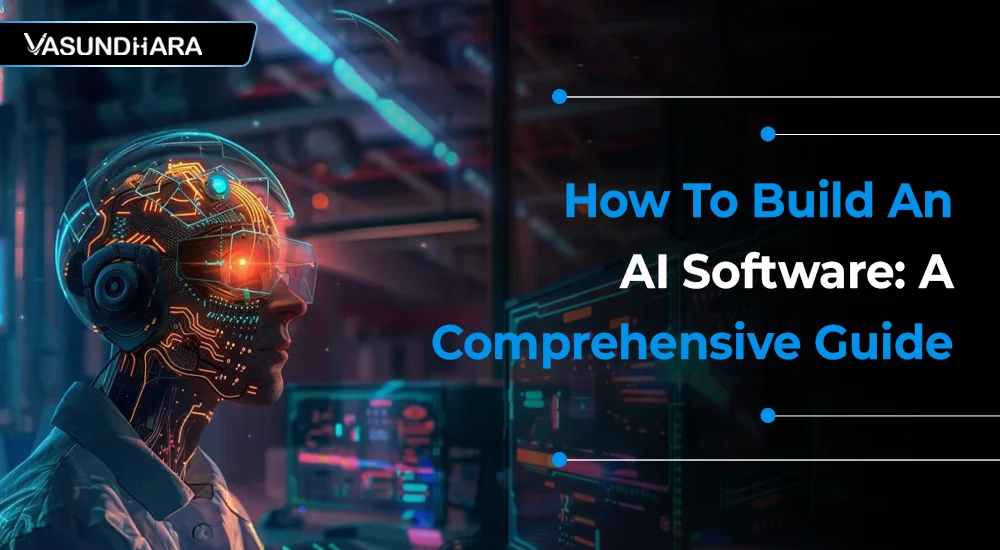How To Build An AI Software: A Comprehensive Guide


- May 30, 2024
Artificial Intelligence (AI) is revolutionizing the way we interact with technology, making it a cornerstone of modern innovation. AI systems have become integral to numerous industries, driving advancements that improve efficiency, accuracy, and user experience. From self-driving cars and intelligent personal assistants to advanced data analytics and personalized recommendations, AI is transforming the world around us. AI market size is expected to grow by at least 120% year-over-year.
This comprehensive guide aims to demystify the process of building AI software, providing a clear, step-by-step approach. Whether you're a beginner just starting to explore the world of AI, an intermediate developer looking to enhance your skills, or a tech enthusiast eager to delve deeper into this exciting field, this guide is designed to help you navigate the complexities of AI development. By the end, you'll have a solid foundation and the confidence to embark on your own AI projects.
Artificial Intelligence (AI) refers to the simulation of human intelligence in machines designed to think, learn, and perform tasks that typically require human intelligence. These tasks include reasoning, problem-solving, understanding natural language, perception, and decision-making. AI systems are built to process vast amounts of data, recognize patterns, and make decisions with minimal human intervention.
Also read: The Role of AI and ML in DevOps Transformation
Narrow AI refers to AI systems that are designed and trained to perform a specific task. These systems operate under a limited set of constraints and are unable to perform tasks outside their specific domain.
Examples include virtual assistants like Siri and Alexa, recommendation algorithms used by Netflix and Amazon, and autonomous vehicles.
General AI, also known as strong AI, refers to AI systems with the ability to understand, learn, and apply knowledge across a wide range of tasks, much like a human being.
These systems possess cognitive abilities that enable them to reason, solve problems, and adapt to new situations without human intervention.
Superintelligent AI refers to an advanced form of AI that surpasses human intelligence and capability. This level of AI would possess cognitive abilities far superior to that of the smartest humans in every field, including scientific creativity, general wisdom, and social skills.
Generative AI is also transforming traditional processes and introducing new paradigms across various fields, creating opportunities for innovation and efficiency that were previously unimaginable.
AI software refers to computer programs and algorithms designed to mimic human intelligence, enabling machines to perform tasks that typically require human cognition. These tasks include problem-solving, pattern recognition, decision-making, and natural language understanding. AI software analyzes vast amounts of data, learns from patterns, and adapts its behavior over time, leading to improved performance and efficiency. The AI software market's global annual revenue is currently over $50 billion.
AI software finds applications across various industries, revolutionizing processes and driving innovation. Some key applications include:
AI software assists in medical diagnosis, personalized treatment planning, drug discovery, and patient monitoring.
AI algorithms are used for fraud detection, risk assessment, algorithmic trading, and customer service automation.
AI software powers recommendation systems, demand forecasting, supply chain optimization, and customer service chatbots.
AI enhances predictive maintenance, quality control, process optimization, and robotics automation.
AI drives autonomous vehicles, optimizes traffic management, predicts maintenance needs, and provides personalized travel recommendations.
AI software enables content recommendation, content creation, personalized marketing, and interactive gaming experiences.
AI supports personalized learning, automated grading, virtual tutoring, and administrative task automation.
Also read: Google Workspace vs. Microsoft 365: In-Depth Comparison
Building AI software is a complex yet rewarding endeavor that requires careful planning, attention to detail, and a systematic approach. Here's a descriptive guide to help you navigate the process of building AI software:
Before diving into the technical aspects of AI development, it's crucial to define the problem you intend to solve clearly. Take the time to understand the objectives, constraints, and potential impact of the AI software. This initial step sets the foundation for the entire development process, guiding subsequent decisions and actions.
Imagine you're tasked with developing an AI-powered recommendation system for an e-commerce platform. Begin by identifying the specific problem you aim to address—whether it's improving product recommendations to enhance user engagement, increasing sales conversion rates, or reducing customer churn.
With the problem defined, the next step is gathering and preparing the data to fuel your AI model. Data is the lifeblood of AI software, providing the raw material from which insights are derived and decisions are made. Collect relevant datasets that align with your problem statement and project objectives.
Continuing with the e-commerce recommendation system example, you'll need historical data on user interactions, such as past purchases, product views, and user ratings. Ensure the data is representative, diverse, and sufficiently large to train a robust AI model.
Once collected, preprocess the data to ensure it's clean, consistent, and suitable for analysis. This may involve tasks such as removing duplicates, handling missing values, and standardizing formats. Additionally, consider performing feature engineering to extract meaningful features that capture relevant patterns and insights from the data.
With your data prepared, it's time to select the appropriate algorithms and models that will power your AI software. The choice of algorithms depends on the nature of your problem and the type of data available. For example, if you're dealing with a classification task (e.g., predicting user preferences), algorithms like logistic regression, decision trees, or neural networks may be suitable.
In the case of the recommendation system, you might explore collaborative filtering techniques, matrix factorization methods, or more advanced deep learning approaches like recurrent neural networks (RNNs) or convolutional neural networks (CNNs).
Designing the architecture of your AI model involves making decisions about the number of layers, neurons, activation functions, and optimization algorithms. Experiment with different configurations and architectures to find the optimal balance between model complexity and performance.
Once you've selected the algorithms and designed the model architecture, it's time to train and validate the model using your prepared data. Split your dataset into training, validation, and test sets—typically, a 70-15-15 split is common. The training set is used to train the model, the validation set is used to tune hyperparameters and monitor performance, and the test set is used to evaluate the final model's performance.
During the training process, feed the training data into the model and iteratively adjust the model parameters to minimize the error or loss function. Monitor the model's performance on the validation set and fine-tune hyperparameters as needed to improve performance and prevent overfitting.
With the model trained and validated, it's essential to evaluate its performance using appropriate evaluation metrics. The choice of metrics depends on the specific problem you're solving—common metrics for classification tasks include accuracy, precision, recall, F1-score, and area under the ROC curve (AUC).
Continuing with the recommendation system example, you might evaluate the model's performance based on metrics such as precision@k, recall@k, or mean average precision (MAP), where k represents the number of top recommendations provided to users.
Performing cross-validation—a technique for assessing how well the model generalizes to unseen data—can provide additional insights into the model's robustness and reliability.
Even the most well-designed models can benefit from optimization and fine-tuning to improve performance further. Experiment with different hyperparameters, such as learning rates, batch sizes, and regularization techniques, to find the optimal configuration.
Hyperparameter tuning techniques like grid search, random search, or Bayesian optimization can help automate the process of searching for the best hyperparameter values efficiently.
Consider conducting feature selection to identify the most relevant features that contribute to the model's predictive power. Eliminating irrelevant or redundant features can simplify the model, reduce computational complexity, and improve interpretability.
With the model trained, validated, and optimized, it's time to deploy it into production. Integration is a crucial step in this process, as the AI model needs to seamlessly integrate into the target application or system. Develop APIs or interfaces that allow other systems to interact with and utilize the model's predictions.
Choose an appropriate deployment environment based on factors such as scalability, performance, security, and cost. Cloud platforms like Amazon Web Services (AWS), Google Cloud Platform (GCP), or Microsoft Azure offer scalable and reliable infrastructure for hosting AI models. Alternatively, consider deploying models to edge devices for real-time inference and low-latency applications.
Before deployment, thoroughly test the model in a production-like environment to ensure it functions as expected and meets performance requirements. Monitor the model's performance post-deployment and implement mechanisms for error handling, logging, and version control to facilitate maintenance and troubleshooting.
Deploying an AI model into production is not the end of the journey—it's just the beginning. Continuous monitoring and maintenance are essential to ensure the model remains effective and reliable over time.
Establish performance monitoring mechanisms to track key metrics and detect any deviations or degradation in model performance. Set up alerts and notifications to notify stakeholders of any anomalies or issues that require attention.
Implement a feedback loop to collect user feedback and observations from the real-world deployment environment. Use this feedback to identify areas for improvement, refine model predictions, and prioritize future enhancements.
Regularly maintain the model by updating dependencies, retraining the model with new data, and addressing any issues or bugs that arise. Version control is essential for tracking changes and ensuring reproducibility across different model versions.
By actively monitoring and maintaining the model, you can ensure its continued effectiveness and value to the organization and stakeholders.
Building AI software is a multifaceted endeavor that demands careful planning, experimentation, and continuous learning. Each step requires attention to detail and a systematic approach, from defining the problem and gathering data to training models, deploying solutions, and maintaining them in production.
Despite the challenges, embarking on AI projects offers exciting opportunities to drive innovation, solve complex problems, and make a meaningful impact across industries. By embracing curiosity, staying adaptable, and leveraging the resources available, anyone can start their AI journey and contribute to advancing this dynamic field.
So, whether you're a seasoned professional or a curious beginner, now is the time to dive in, explore, and unleash the power of AI to shape a better future.
Our experts at Vasundhara Infotech specialize in all aspects of the latest technologies. If you require any services for software development, or other purposes, please contact us. We have a team of professionals ready to assist your business expand massively in every manner.
Copyright © 2025 Vasundhara Infotech. All Rights Reserved.
